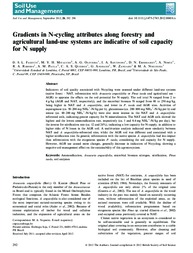Gradients in N-cycling attributes along forestry and agricultural land-use systems are indicative of soil capacity for N supply.
Gradients in N-cycling attributes along forestry and agricultural land-use systems are indicative of soil capacity for N supply.
Author(s): NOGUEIRA, M. A.
Summary: Indicators of soil quality associated with N-cycling were assessed under different land-use systems (native forest ? NAT, reforestation with Araucaria angustifolia or Pinus taeda and agricultural use ? AGR) to appraise the effects on the soil potential for N supply. The soil total N ranged from 2 to 4g⁄ kg (AGR and NAT, respectively), and the microbial biomass N ranged from 80 to 250 mg⁄ kg, being higher in NAT and A. angustifolia, and lower in P. taeda and AGR sites. Activities of asparaginase (ca. 50?200 mg NH 4 + -N ⁄ kg per h), glutaminase (ca. 200?800 mg NH -N ⁄ kg per h) and urease (ca. 80?200 mg NH -N ⁄ kg ⁄ h) were also more intense in the NAT and A. angustifoliareforested soils, indicating greater capacity for N mineralization. The NAT and AGR soils showed the highest and the lowest ammonification rate, respectively (ca. 1 and 0.4 mg NH 4 + -N ⁄ kg per day), but the inverse for nitrification rate (ca. 12 and 26%), indicating a low capacity for N supply, in addition to higher risks of N losses in the AGR soil. A multivariate analysis indicated more similarity between NAT and A. angustifolia-reforested sites, whilst the AGR soil was different and associated with a higher nitrification rate. In general, reforestation with the native species A. angustifolia had less impact than reforestation with the exogenous species P. taeda, considering the soil capacity for N supply. However, AGR use caused more changes, generally decrease in indicators of N-cycling, showing a negative soil management effect on the sustainability of this agroecosystem.
Publication year: 2012
Types of publication: Journal article
Unit: Embrapa Soybean
Keywords: Ammonification, Amonificação, Nitrification, Nitrificação, Qualidade, Soil quality, Solo
Observation
Some of Embrapa's publications are published as ePub files. To read them, use or download one of the following free software options to your computer or mobile device. Android: Google Play Books; IOS: iBooks; Windows and Linux: Calibre.
Access other publications
Access the Agricultural Research Database (BDPA) to consult Embrapa's full library collection and records.
Visit Embrapa Bookstore to purchase books and other publications sold by Embrapa.

